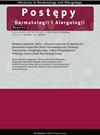皮肤病学的局部主动治疗。范围审查。
IF 1.4
4区 医学
Q3 ALLERGY
引用次数: 0
摘要
“主动治疗”一词是指对先前患病区域的临床完整皮肤进行长期管理。该方法最初用于特应性皮炎,以维持缓解并降低恶化的风险。主动治疗的目的是限制对反应性治疗的需要,提高患者的生活质量。在未来,对于其他复发和炎症性皮肤状况,可能会采取积极主动的方法。本综述旨在确定采用主动方法治疗的皮肤病,评估其有效性和安全性的现有证据,并突出研究空白。本文章由计算机程序翻译,如有差异,请以英文原文为准。
Topical proactive therapy in dermatology. A scoping review.
The term 'proactive therapy' refers to a long-term management of clinically intact skin in previously disease-affected areas. This method was initially implemented in atopic dermatitis to maintain the remission and decrease the risk of exacerbations. Proactive therapy aims to limit the need for reactive treatment and improve the patients' quality of life. A proactive approach is likely to be adopted for other relapsing and inflammatory skin conditions in the future. This scoping review aims to identify dermatological conditions to be treated with the proactive approach, evaluate the available evidence for its efficacy and safety, as well as highlight the research gaps.
求助全文
通过发布文献求助,成功后即可免费获取论文全文。
去求助
来源期刊

Postepy Dermatologii I Alergologii
ALLERGY-DERMATOLOGY
CiteScore
2.60
自引率
7.10%
发文量
107
审稿时长
6-12 weeks
期刊介绍:
Advances in Dermatology and Allergology/Postępy Dermatologii i Alergologii is a bimonthly aimed at allergologists and dermatologists.
 求助内容:
求助内容: 应助结果提醒方式:
应助结果提醒方式:


